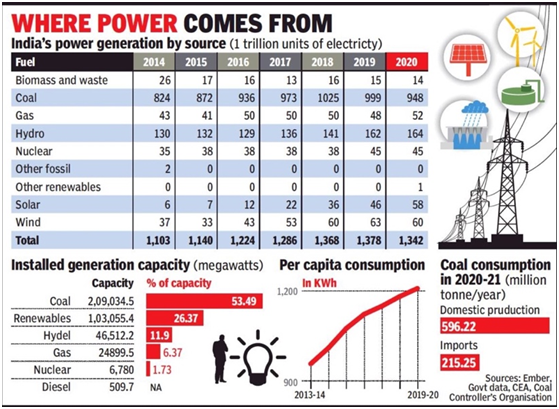Why in the News?
Prolonged exposure to coal mining pollutants has resulted in widespread respiratory and skin diseases among the workers and people in six districts in India, where coal extraction is a major occupation.
What’s in Today’s Article?
- About the Study (Objective, Impact on Communities, Health Impact, Shift from Coal)
- India’s Dependency on Coal
About the Study:
- A survey was conducted by the National Foundation for India which is an organisation that works on social justice issues.
- It conducted a survey, involving 1,200 households, to study the prolonged exposure to coal mining pollutants on the mining workers.
- The six districts covered for the survey were Koriya and Raigarh (Chhattisgarh), Dhanbad and Ramgarh (Jharkhand), Angul and Jajpur (Odisha).
- The surveys, on average, spanned 18-20 villages per district.
Key Findings of the Study:
- Impact on Marginalised Communities:
- It was found that 81.5 per cent among those surveyed belonged to the marginalised SC, ST, and OBC communities and the rest were from the general category.
- The survey found lower levels of income and educational attainment among SC and ST groups compared to OBC groups, and their higher representation in low-paying, irregular jobs in coal-dumping yards, coal sidings, coal loading, coal transport, coal washeries and other informal work.
- This disparity, the report said, indicated the challenges that marginalised groups will face as India gradually phases down coal use, resulting in significant job losses and economic downturns in coal-dependent regions.
- Impact on Health:
- People living closer to the mines were relatively more vulnerable.
- Dhanbad and Ramgarh, which had more people living in such zones, had higher incidence of lung and breathing-related diseases as well as skin infections.
- At least 65% of participants interviewed reported issues such as chronic bronchitis, asthma, and skin ailments such as eczema, dermatitis and fungal infections.
- On average, a household in these districts spent ₹300 to ₹1,000 on monthly medical-related bills.
- The average annual hospitalization expenses in Dhanbad (₹28,461 per household) were the highest.
- Shift from Coal:
- The main goal of the study was to explore the concept of a 'just transition' – finding effective and sensitive ways to help individuals who depend on coal mining to move away from these jobs.
- As the world moves away from coal, significant job losses and economic declines are anticipated in coal-dependent regions.
- This shift will affect not only coal miners and workers directly but also the wider local economy.
India’s Dependence on Coal for Energy Supply:

- While renewable energy capacity is dramatically increasing, coal still provides around 70 per cent of the country’s electricity.
- Coal is expected to account for at least 21 per cent of India’s electricity requirements even by 2050.
- Easily Available Source of Power:
- Coal can help the country meet its energy needs without depending on imports as it is abundantly available domestically.
- Alternatives like nuclear energy have been hampered by high costs and safety concerns.
- India’s Developmental Needs:
- To lift millions of people out of poverty, India needs energy.
- The International Energy Agency (IEA) predicts that between 2020 and 2040, India will have the largest growth in energy demand of any country in the world.
- To meet this demand, India will need to rely on a variety of energy sources—both conventional and renewable.
- Source of Employment:
- Beyond providing desperately needed energy, coal is also a vital source of jobs and economic growth and a driver of industrialization, just as it was in developed countries.
- Around 4 million people in India are employed either directly or indirectly in the coal sector.
- Other than active workers, another 500,000 Indians rely on the coal sector for their pensions.
- Source of Revenue for the Government:
- Coal India Limited is the largest coal mining company in the world.
- The coal sector is a major source of revenue for States and the Central Government.









